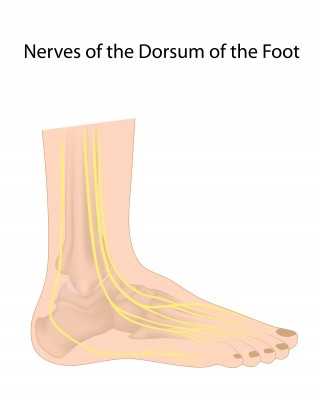Peripheral Nerve Disorder

Dorsal digital nerves of foot, commonly affected in diabetic neuropathy
Peripheral nerves connect the brain and spinal cord with the rest of the body. When these nerves are damaged, communication between the brain and the body is compromised. These disorders are more common in older patients. Any peripheral nerve can malfunction, which may affect sensation, movement, or the function of internal organs.
This group of disorders may be either inherited or acquired. Many factors can contribute to developing peripheral nerve disorders, including physical injury, exposure to toxins, autoimmune responses, vitamin deficiencies (E, B1, B6, B12), infections, and alcohol consumption. Other underlying conditions, including diabetes, kidney disorders, tumors, and hypothyroidism may also cause nerve damage. Certain medications may also result in nerve disorders and sometimes the cause of these disorders is not known. Peripheral nerve disorders can affect one nerve (mononeuropathy) or multiple nerves (polyneuropathy). A common example is Carpal Tunnel Syndrome, a mononeuropathy caused by entrapment of the median nerve at the wrist. Damage to multiple peripheral nerves is more common than damage to a single nerve.
Because each nerve has a specific role in the body, peripheral nerve disorders can manifest in many different ways. Symptoms of peripheral nerve disorders vary depending on which nerves are affected, and are limited to the distribution of these specific nerves. Common symptoms include muscle weakness, loss of sensation, paralysis, tingling, numbness, sharp or burning pain, and abnormal sensations. These symptoms often affect the hands and feet symmetrically. If nerves controlling autonomic functions are damaged, body functions such as heart rate and digestion may be affected. Generally symptoms are mild when they begin, but become more severe over time.
Diagnosis of peripheral neuropathy requires a medical history and physical examination. Other tests may be required to determine how the nerves became damaged. Possible further testing might include blood tests, CT scan, MRI scan, electromyography, nerve conduction studies, or a nerve biopsy. Different types of peripheral nerve disorders may need different tests in order to be accurately diagnosed.
The goal of treatment is to reduce symptoms. Peripheral nerve disorders can sometimes be managed with self-care measures. Chiropractic, acupuncture, massage, exercise, and decreasing exposure to alcohol and cigarettes may be effective. Moderate pain can be controlled with over-the-counter pain medications and anti-inflammatories. Prescription medications, including narcotics, antiepileptics, and antidepressants may be helpful. Other possible treatments may include blood transfusions, nerve blocks, and transcutaneous electronic nerve stimulation.
If any underlying disorders are contributing to nerve damage, these should be addressed as part of treatment. For example, controlling diabetes can limit the effect of diabetic nerve damage. If the nerve disorder is caused by entrapment, as in Carpal Tunnel Syndrome, then physical therapy, injections, or surgery may prove effective. Treatment for various types of peripheral nerve disorder is currently a subject of medical research.
Sources:
“Peripheral Nerve Disorders.” Available on: http://www.nlm.nih.gov/medlineplus/peripheralnervedisorders.html
“Peripheral Neuropathy.” Available on: http://www.medicinenet.com/peripheral_neuropathy/article.htm
“Peripheral Neuropathy.” Available on: http://www.healthline.com/health/peripheral-neuropathy#Overview1
“Understanding Peripheral Neuropathy – the Basics.” Available on: http://www.webmd.com/brain/understanding-peripheral-neuropathy-basics
